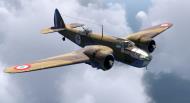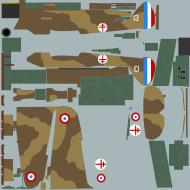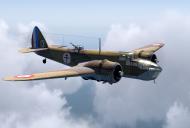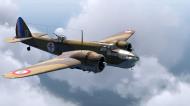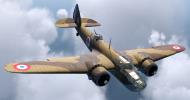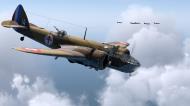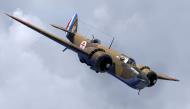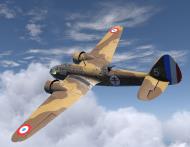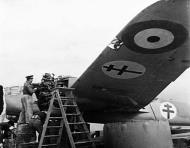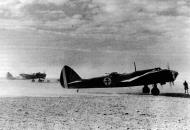Free French Bristol Blenheim's mixed photo gallery
Aircraft and unit emblem FAF Lorraine 0A
Aircraft and unit emblem the officially registered crest of Groupe Lorraine
Art painting of Free French Blenheim MkIVF Groupe Lorraine over Syria 1941
Artist: © Jouni Ronkko 'Jones' Source: FAF Aircraft In WWII
Artwork Blenheim MkIV French AF White 4 N3522 Damascus Syria 1941 0A
Free French Blenheim MkIVF ground crew repairing the left engine 1941
Free French Blenheim MkIVF Groupe Lorraine No 11 and 12 over Syria 1941 01-02
Free French Blenheim MkIVF Groupe Lorraine No 14 Faya Aleppo Damascus Syria 1941
Free French Blenheim MkIVF Groupe Lorraine No 18 Faya Aleppo Damascus Syria 1941
Free French Blenheim MkIVF Groupe Lorraine No 4 Faya Aleppo Damascus Syria 1941 01-02
Free French Blenheim MkIVF Groupe Lorraine No 5 Faya Aleppo Damascus Syria 1941
Free French Blenheim MkIVF Groupe Lorraine Zx533 Faya Aleppo Damascus Syria 1941 01
Free French Blenheim MkIVF White 13 photo by Time Life 1941 01
Free French Blenheim MkIV Groupe Lorraine No 12 Faya Aleppo Damascus Syria 1941
Free French Bristol Blenheim's MkIV's
If Lorraine Bombardment Group was officially born September 24th 1941, in Damascus, Syria, most of the constituent elements have fought for almost a year in Gabon, Kufra and Chad. Often with insufficient means, but a fierce determination to continue the struggle. As of November 1940, General de Larminat Chad created the Group booked bombing # 1 (GRB1), under the command of Captain Astier de Villatte.
The group, part of which has previously helped rally Gabon, soon provides support troops of Colonel Leclerc . Missions, including when taking Kufra in March 1941, held in harsh conditions: heat, sand, inadequate infrastructure.
The GRB1 operates then, from April to July 1941, in Abyssinia - which makes it 130 missions - and Eritrea. On his return, he is based near Damascus and combined with the Bomber Group No. 2, commanded by Captain Goussault . September 2, 1941, the two units are dissolved to form Bombardment Group 1 Lorraine, consisting of two squadrons Metz and Nancy under the command of Captain St. Péreuse succeeded by the commander in October Corniglion-Molinier . Equipped bomber Blenheim , Lorraine Group has the support of the Royal Air Force .
From November to December 1941, he multiplies over Libya missions in support of the British Army. On November 23, in particular, it destroyed a column of tanks. But its losses are also terrible. In December, Lt. Col. Pijeaud , from England took command of the group, but he is mortally wounded during his first mission. He was replaced by Captain de Saint-Péreuse.
The Afrika Korps stopped, the Allied offensive Lorraine supports. In 16 days in January 1942, the Group performs 300 attractions before joining the Levant, a third of the crew is then injured or missing.
In Syria, the Group is divided into two squadrons autonomous one (Nancy) based in Damascus and the other (Metz) Rayack in Lebanon. Both units are responsible for ferrying aircraft and coastal surveillance. During one of these missions, the squadron Nancy device damaged a German submarine. In October 1942, the Lorraine sailed to Suez for Great Britain to serve on the Western Front.
Reached Greenock on 1st January 1943, all staff of the group is sent training before the reformation of Lorraine April 7, 1943, at West Raynham. Under the command of Rancourt , he became the 342 Squadron of the Royal Air Force in the 137th Wing and equipped with Douglas Boston III , he was engaged in bombing missions day and night, medium or low altitude.
Missions over France and Holland are very diverse: power stations, marshalling yards, airfields, VI sites ... October 3, 1943, the Group now based at Hartford Bridge, Hampshire, bombed and destroyed 90% of the post processing which Chevilly-Larue, south of Paris, the Paris region supplying electricity. Passed under the command of Michel Fourquet in December 1943, Lorraine specializes in spring 1944 in the night bombing.
June 6, 1944 in the Normandy landings, it deposits at six o'clock in the morning, along the coast, a smoke screen to protect the allied fleet of German bombing at the very low altitude of 50 feet (15 meters !). The mission was a complete success. Operations over Normandy succeed in very difficult conditions and deadly as the night attack at low altitude (50 meters) of the German armored divisions encircled in the Falaise August 5, 1944. In the first week of August, Lorraine lost 5 crew ...
On 17 October 1944, the aircraft landed in France, Vitry-en-Artois, where their new database and Lorraine soon passes under the command of Jacques bellows . After breaking the front, the Group participates in all operations which mark the advance of Marshal Montgomery: Battle of the Bulge, crossing the Rhine, Arnhem, destruction of bridges on the Rhine ... Recently with U.S. bomber B25 Mitchell and installed Gilzerijzen Holland, the Group carries out its last wartime mission May 2, 1945. May 28, 1945, he was awarded the Croix de la Libération . He lost 127 crew members, more than double its normal strength. During the conflict, he has spilled more than 2,500 tons of bombs over 3000 outlets. June 10, 1945, it scrolls with 3000 Allied planes over Frankfurt. Eight days later, he flew over the Champs-Élysées in forming its emblem: the Cross of Lorraine.
As the individual Bombardment Group Lorraine scored 54 Companions of the Liberation. Since September 2005, the squadron 3/33 Lorraine was put to sleep. It should be reactivated on the Air Base 113 Saint-Dizier-Robinson to fly Rafale.
Companion of the Liberation - Decree of 28 May 1945 Croix de Guerre 39-45 (7 citations)
The Bombardment Group Lorraine is a military unit of the French Air Free French Air Forces formed during the Second World War who distinguished himself in North Africa and Western Europe.
This flight training comes the fighter squadron 3/33 "Lorraine" , unit stationed on the air base 112 "the Commander Marin Meslée" of Reims from 1961 to 2005 and mothballed at that time.
Creation and different denominations
November 1940 : Bombing Group reserved No.1 (GRB 1) 24 September 1941 : GRB 1 becomes Bombardment Group No. 1 "Lorraine" (Lorraine GB) 1 7 April 1943 : The UK "Lorraine" is integrated into the command of the Royal Air Force under the name of No.342 Squadron
Commanders
Group leaders Lorraine GB
November 1940 - September 1941 : Commander Jean Astier de Villatte September 1941 - October 1941 : Captain Pierre Tassin St. Péreuse October 1941 - December 1941 : Commander Edward Corniglion-Molinier December 1941 : Lieutenant-Colonel Charles Pijeaud December 1941 - June 1942 : Captain Pierre Tassin St. Péreuse
Group leaders GB Lorraine, No. 342 Squadron
7 April 1943 - December 1943 : Lieutenant-Colonel Henri de Rancourt Mimerand December 1943 - November 1944 : Commander Michel Fourquet November 1944 - February 1945 : Lieutenant-Colonel Jacques Bellows February 1945 - July 1945 : Commander Gustave Mentré 2 1945 - 1947: Commander Jean-Louis Garot 3
History
Left England in September 1940 to join Equatorial Africa and the Middle East , the group Lorraine is the first unit of the Free France . It is equipped with Hawker Hurricane , Westland Lysander and Bristol Blenheim . In December 1940 , he became Group Recognition and Bombardment Bombardment Group and No. 1 in March of the following year. He was baptized Lorraine September 2, 1941. It is attached to the RAF April 7, 1943 as 342nd Squadron, consisting of two squadrons: Metz and Nancy and flies Boston.
Passed under the command of Michel Fourquet in December 1943, "Lorraine" specializes in spring 1944 in the night bombing. During the Normandy landings, the Group raises at six o'clock in the morning, along the coast, a smoke screen to protect the allied fleet of German bombing: altitude 50 feet! The mission was a complete success. On 17 October 1944, the aircraft landed in France, Vitry-en-Artois , where their new base and "Lorraine" soon passes under the command of Jacques bellows.
After breaking the front, the Group participates in all operations which mark the advance of Marshal Montgomery: Battle of the Bulge, crossing the Rhine, Arnhem, destruction of bridges on the Rhine ... In early 1945 , with U.S. bomber B-25 Mitchell and installed Gilzerijzen Holland, the Group carries out its last wartime mission May 2, 1945.
The writer Romain Gary was a member of Lorraine and wrote in it including Education European operations in the fall of 1943. He recounts several episodes of the group during the war in The Promise of dawn and took him for a fellow pilot model to compose the character of Morel The Roots of Heaven.
After the war, in October 1946 , the squadron is to Cambrai . Became Group Recognition GR 1/31, he flew Mosquito to specialize in night hunting. He became Group Hunting Night GCN 1/31 in April 1951 on Meteor NF11 . He settled on the basis of Tours in 1952 . This group becomes the 30th Wing Hunting Night in July 1953
February 1961 : The squadron of Vulture IIN is transferred to the Air Base 112 "the Commander Marin Meslée" of Reims.
February 1974 : beginning of the passage of Mirage F1C.
In September 1988 , the squadron receives Mirage F1B squadron to become fighter pilots transformation of Mirage F1C . A third squadron is attached to the unit: SPA 62 Shamo . The squadron was renamed EC 3/33 Lorraine in June 1994. It retains its mission of transformation and CT Mirage F1CR , always equipped with F1B and C. These are officially decommissioned 25 June 2003
The Bombardment Group 'Lorraine'
by Yves Dungeon
The Bombardment Group 'Lorraine', Hope No. 129, January 2002
The Free French Air Forces (FAFL) saw officially on 1st July 1940, when it became the first symbol in a text FAFL where General de Gaulle confided to Vice-Admiral Muselier "command of the naval forces and French remained free Air Force temporarily. "
July 11, 1940, created the French Bomber Flight No. 1, under the command of Captain Ritoux-Lachaud in Aden (Yemen).
The Group booked bombing # 1 (GRB 1) was the first unit in the FAFL. It was created December 24, 1940 in French Equatorial Africa I (AEF). Under the command of Captain Astier de Vilatte, this unit consists of:
1) Fort-Lamy (Chad) Command Post of the Group; formed the first squadron of six Blenheim commanded by Captain Lager. This unit comes from a mixed group of combat No.1 "Jam". 6 Blenheim which must form the first squadron of one GRB join Fort-Lamy in late December 1940 where they found the squadron 4 Lysander Captain GMC also coming Christmas No. 1.
2) to Maiduguri (northeast Nigeria): the second squadron eg "Topic" consisted of 8 Blenheim commanded by Lieutenant Saint-Péreuse. This unit whose aircraft were landed in boxes and brought to Takoradi ( Ghana) regrouped in Maiduguri just a few days before being incorporated into the new group.
Now, there will be no more "Topic" or "Jam" and GRB 1, with the wrong equipment, faulty or insufficient, inexperienced crews most often required for missions in the desert, will prepare provide support to its Blenheim fighters to land.
Allocated firstly to support the troops of Colonel Leclerc in the transactions contemplated against Kufra and Mourzouk (Libya) with the intent to protect the territories allies attack Italo-German arising from Tripoli, the Group won his first success but these are unfortunately paying dearly for the expedition against Kufra and the Group has withdrawn the limit of exhaustion. Some crews will reinforce the RAF units that support the troops who are fighting against the Italians in Somalia, Ethiopia and Eritrea.
The Group participates in the operations of Abyssinia from 24 March 1941.
The unit received from the RAF on 1 April 1941, a reinforcement of six Blenheim is available to the 202 Group RAF and, from the field of Gordon's Tree, busy April 28, performs a series of missions against the Italian positions in Abyssinia.
August 15, GRB one moved to Damascus (Syria).
September 2, 1941, GRB one is officially the name "Lorraine Group." It consists of two squadrons: "Metz" (captain Lager) and "Nancy" (Captain Gousseault).
Pending the arrival of Lieutenant-Colonel Pijeaud the command is carried out by Captain de Saint-Péreuse.
On November 20, the band joins LG 75 field fifty kilometers south of Sidi Barrani and works with the 210th Wing British against the Axis forces in Libya. On December 17, Lieutenant Colonel Pijeaud took command of the group that moved on the next field Gambut.
On 20 December, the aircraft of Lieutenant Colonel Pijeaud, reached by a shot from the opposing fighter, crashed in flames. Colonel Felix Pijeaud, badly burned, succumb to the hospital in Alexandria January 6, 1942. Captain de Saint-Péreuse assumed command of the group.
Between 11 and 17 January 1942, the group made numerous attacks on heavily defended position of "Halfaya Pass," which earned him the congratulations of the 210th Wing for effective bombing.
January 31, 1942, the group "Lorraine", after the last campaign in Libya, Syria joined the staff which is put to rest. Party with 17 crew, the group lost five full crews.
February 1, 1942, Colonel Corniglion-Molinier, responsible FAFL the Middle East, passes command of the "Lorraine" Captain Pouliquen.
End of October 1942, after a period of reorganization and rest, "Lorraine" left for England. Some of the staff embarked on Ordunia 22 October and arrived at Greenock (Scotland) December 31, 1942. The group "Lorraine" had lost since 1940, 29 pilots, observers and gunners. A new page was turned.
March 13, 1943, aboard the Empress of Canada , sailing out of convoy Durban (South Africa) to England, are the staff "Lorraine". Unfortunately, the ship is torpedoed and some perish.
On 7 April 1943, the "Lorraine" joins the base of West Raynham in Norfolk and takes the name of the 342nd Squadron . The group is controlled by the commander Rancourt, the squadron "Metz" by the captain and flight Ezanno "Nancy" by Captain Charbonneaux. The group was ready for her first war mission on the European theater, with its new car, the Douglas "Boston" . The first mission took place on 12 June 1943, the aim being a refinery near Rouen.
On 14 July 1943, the group made its first autonomous mission by bombing the airfield at Abbeville.
On August 19, the group moves on airfield Hartford Bridge.
On 20 September 1943, the Commander-Garri Fourquet was appointed second in command of Group Captain Langer and took command of the squadron "Metz".
On 3 October, the group participates in the destruction of the power plant Chevilly-Larue, this mission is characteristic of a high-precision bombing at very low altitude.
December 23, 1943 took place the first attack group at low altitude, a launching pad for V1.
On 6 February 1944, Captain Barberon took command of the squadron "Nancy". On March 20, Lt. Col. Garri-Fourquet succeeds Colonel Rancourt at the head of "Lorraine".
On 6 June 1944, the Allies landed in Normandy. Twelve Boston 's "Lorraine", taking off in pairs, ten minutes after ten minutes, tend to the fleet landing a smoke from the tip of Barfleur to the mouth of the Vire area assigned to U.S. forces .
August 4, 1944 was a tragic day for the "Lorraine" which loses four of its aircraft during night missions harassment. Sixteen crew members are missing.
On 29 September, the group performed its first operation in Germany, with the aim Gelden station.
On October 17, the group leaves Hartford Bridge to settle in France, Vitry-en-Artois (Pas-de-Calais). Between 12 June 1943 and 17 October 1944, the losses of "Lorraine" will amount to 68 dead, 32 wounded and 10 prisoners. November 7, 1944, the commander Bellows took command of the group. February 14, 1945, the commander Mentré succeeds commander bellows. His command will be short since March 23, 1945, the captain Garot is designated as commander of the "Lorraine." On the last day of March sees the arrival of the North American B.25 " Mitchell "which replace the Boston .
April 10, 1945, the "Lorraine" was awarded the Cross of the Liberation as with last quote: "The Cross is awarded to the Liberation Bombardment Group Lorraine, a veteran of the Free French Air Training, legendary group, at a price of heavy losses, has gloriously fought for honor and liberation of France ... ".
April 22, 1945, the "Lorraine" left Vitry-en-Artois and settled in Holland based on operational B 17 (Gilze-Rigem). The last war mission of the unit will be held May 2, 1945.
May 28, 1945, the "Lorraine" received the Cross of the Liberation. He lost over 100 of its crew members, more than double its normal strength. During the conflict, he has spilled more than 2,500 tons of bombs over 3000 outlets.
June 10, 1945, it scrolls with 3000 Allied planes over Frankfurt. Eight days later, he flew over the Champs-Elysées in forming its emblem: the Cross of Lorraine.
Fort Lamy (1st PC Esc) 15/12/40 24/09/41 Maiduguri (2nd Esc) Khartoum (Sudan) 15/12/40 24/09/41 Damascus (Syria) 24/09/41 30/10/41 Abu Sueir - Lot 10 (Egypt) 30/10/41 15/11/41 Fuka - Lot 16 (Egypt) 15/11/41 19/11/41 Sidi Barrani - Lot 75 (Egypt) 19/11/41 18/12/41 Gambut (Libya) 18/12/41 01/02/42 Abu Sueir - Lot 10 (Egypt) 01/02/42 01/03/42 Rayack (Syria) 01/03/42 24/10/42 Transit boat 24/10/42 01/01/43 Overhaul of the Squadron 01/01/43 03/43 West Raynham (Norfolk - UK) 07/04/43 15/05/43 Sculthorpe (Norfolk - UK) 15/05/43 17/07/43 Great Massigham (Norfolk - UK) 17/07/43 19/09/43 Hartfordbridge (Hampshire - UK) 19/09/43 15/10/44 Vitry en Artois (France) 15/10/44 21/03/45 Gilze Rijen (Holland) 21/03/45 08/05/45
Bibliography:
- Air Ministry Pilot's Notes: Blenheim. London: OHMS/Air Data Publications, 1939.
- Air Ministry Pilot's Notes: Blenheim V. London: OHMS/Air Data Publications, 1942.
- Barnes, C.H. Bristol Aircraft Since 1910. London: Putnam, 1970. ISBN 0-85177-804-6.
- Boiten, T. Bristol Blenheim. Ramsbury, Marlborough, Wiltshire, UK: The Crowood Press, 1998. ISBN 1-86126-115-2.
- Bowyer, C. Bristol Blenheim. London: Ian Allen, 1984. ISBN 0-7110-1351-9.
- Chorley, W.R. RAF Bomber Command Losses of the Second World War: 1939-40 v. 1. Earl Shilton, Leicester, UK: Midland Publishing, 1998. ISBN 978-0-904597-85-1.
- Ciglic, Boris and Dragan Savic.Croatian Aces of World War II (Osprey Aircraft of the Aces - 49). London: Oxford, 2002. ISBN 1-84176-435-3.
- Donald, David. The Complete Encyclopedia of World Aircraft. New York: Barnes & Noble, 1997. ISBN 0-7607-0592-5.
- Falconer, Jonathon. The Bomber Command Handbook 1939-1945. Stroud, UK: Sutton Publishing Limited, 1998. ISBN 978-0-7509-1819-0.
- Frith, David. Pageant of Cricket. Melbourne: The MacMillian Company of Australia, 1987. ISBN 978-0-333-45177-9.
- Keskinen, Kalevi et al. Suomen Ilmavoimien Historia 10, Bristol Blenheim (in Finnish). Loviisa, Finland: Painoyhtymä Oy, 2004. ISBN 952-99432-1-0.
- Jefford, C.G. RAF Squadrons: A Comprehensive Record of the Movement and Equipment of All RAF Squadrons and Their Antecedents Since 1912. Shrewsbury, UK: Airlife Publishing 2001. ISBN 1-84037-141-2.
- Lake, Jon. Blenheim Squadrons of World War 2. Oxford, UK: Osprey Publishing, 1998. ISBN 1-85532-723-6.
- Mackay, Ron. Bristol Blenheim in Action. Carrollton, Texas: Squadron/Signal Publications, 1998. ISBN 0-89747-209-8.
- March, Daniel J., ed. British Warplanes of World War II. London: Aerospace, 1998. ISBN 1-874023-92-1.
- Marttila, Jukka. Bristol Blenheim - Taitoa ja tekniikkaa (in Finnish). Vantaa, Finland: Blenimi-Publishing, 1989. ISBN 952-90-0170-3.
- Mason, Francis K. The British Bomber Since 1914. London: Putnam Aeronautical Books, 1994. ISBN 0-85177-861-5.
- Mondey, David. The Hamlyn Concise Guide to American Aircraft of World War II. London: Aerospace Publishing Ltd, 1996. ISBN 0-7858-1361-6.
- Sakaida, Henry. Japanese Army Air Force Aces 1937-45. Oxford, UK: Osprey Publishing, 1997. ISBN 1-85532-529-2.
- Thomas, A. Bristol Blenheim (Warpaint No. 26). London: Hall Park Books, 2000. ISBN 1-84176-289-X.
- Warner, G. The Bristol Blenheim: A Complete History. London: Crécy Publishing, 2nd edition 2005. ISBN 0-85979-101-7.
- Wheeler, Barry C. The Hamlyn Guide to Military Aircraft Markings. London: Chancellor Press, 1992. ISBN 1-85152-582-3.
Magazine References: +
- Airfix Magazines (English) - http://www.airfix.com/
- Avions (French) - http://www.aerostories.org/~aerobiblio/rubrique10.html
- FlyPast (English) - http://www.flypast.com/
- Flugzeug Publikations GmbH (German) - http://vdmedien.com/flugzeug-publikations-gmbh-hersteller_verlag-vdm-heinz-nickel-33.html
- Flugzeug Classic (German) - http://www.flugzeugclassic.de/
- Klassiker (German) - http://shop.flugrevue.de/abo/klassiker-der-luftfahrt
- Le Fana de L'Aviation (French) - http://boutique.editions-lariviere.fr/site/abonnement-le-fana-de-l-aviation-626-4-6.html
- Le Fana de L'Aviation (French) - http://www.pdfmagazines.org/tags/Le+Fana+De+L+Aviation/
- Osprey (English) - http://www.ospreypublishing.com/
- Revi Magazines (Czech) - http://www.revi.cz/
Web References: +
- History of RAF Organisation: http://www.rafweb.org
- Wikipedia, the free encyclopedia: http://en.wikipedia.org/
 Editor for Asisbiz: Matthew Laird Acred
Editor for Asisbiz: Matthew Laird Acred
If you love our website please add a like on facebook
Please donate so we can make this site even better !!











